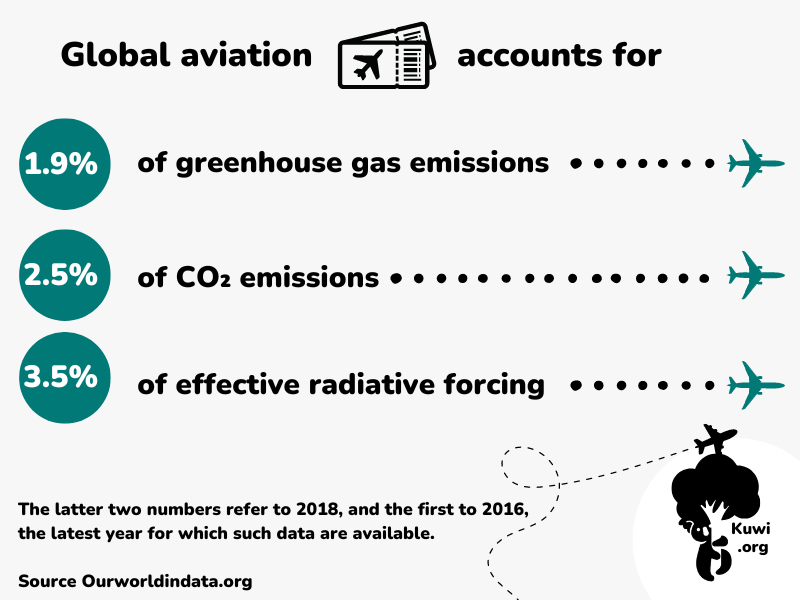A single flight from London to Rome generates more CO₂ emissions than an individual in Kenya produces over an entire year, according to an analysis by The Guardian. These figures underscore the disproportionate ecological footprint of those who can afford to take to the skies.
This year is expected to mark yet another record year for air travel, with passengers projected to fly 8.1 trillion kilometres, equivalent to circling the Earth 200 million times. Flying remains a hot topic in climate debates, responsible for around 2.5% of global CO₂ emissions.
Extensive research has been conducted on aviation’s environmental impact. So, let’s delve into the differences between long-haul and short-haul flights regarding CO₂ and greenhouse gas emissions.
CO₂ and Greenhouse Gas Emissions in Aviation explained
Carbon dioxide (CO₂) stands as the most prevalent greenhouse gas released in aircraft emissions. It emerges during the combustion of aeroplane fuel, primarily composed of hydrocarbons. In addition to CO₂, aeroplanes also release other greenhouse gases into the atmosphere, including water vapour (H₂O), nitrogen oxides (NOx), sulphur oxides (SOx), and aerosols. All these components fall under the greenhouse gas (GHG) category.

What is a Long-Haul Flight
Long-haul flights cover substantial distances, usually spanning continents or oceans. These flights are frequently operated by larger aircraft, like the Boeing 747. These Jumbo Jets consume more fuel due to their size and weight. As long-haul flights endure extended durations, they contribute to higher CO₂ emissions, simply because the engines run for an extended period.
Furthermore, long-haul flights often require reaching greater altitudes, intensifying the emissions’ impact on the Earth’s atmosphere. The increased flight altitude also facilitates the formation of condensation trails (contrails), which further contribute to the warming effect by trapping heat in the atmosphere.
What is a Short-Haul Flight
Short-haul flights typically employ smaller aircraft, often those with a narrow body. This means they consume less fuel than their larger counterparts. However, short-haul flights aren’t exempt from environmental effects, as they frequently involve phases of takeoff and landing that consume a relatively higher amount of fuel.
Even though the fuel consumption per flight is lower for short-haul flights, they still possess a greater environmental impact per passenger per kilometre. This is primarily due to their lower passenger capacity compared to long-haul flights.
Comparing Emissions: Long-Haul vs. Short-Haul Flights.
In general, long-haul flights yield a higher overall CO₂ and greenhouse gas emission compared to short-haul flights. This is largely attributed to the longer flight duration and the larger size of the aircraft. However, when we focus on CO₂ emissions per passenger-kilometer, short-haul flights prove to be far less efficient due to their lower passenger capacity.
How Much CO₂ Does an Airplane Emit?
Various studies, including those conducted by the ONS, reveal that short-haul flights emit between 220 and 260 grams of CO₂ per kilometre, while long-haul flights emit between 185 and 205 grams of CO₂ per kilometre. This variation is mainly due to higher fuel consumption during takeoff and landing. The Office for National Statistics emphasizes that long-haul flights often employ more efficient aircraft and flight paths, contributing to lower emission levels.
Are Short-Haul Flights Worse for the Environment
Research indicates that shorter flights result in higher carbon emissions per passenger compared to long-haul flights. This perspective is also endorsed by Selahattin Incecik, the head of the International Union of Air Pollution Prevention Associations (IUAPPA).
However, when considering the overall climate impact, long-haul flights turn out to be more detrimental to the environment. Flights shorter than 500 kilometres represented a quarter of all European flights, yet accounted for less than 4 per cent of the EU’s total aviation emissions in 2022, as reported by Eurocontrol air traffic controllers. On the other hand, long-haul routes spanning more than 4,000 kilometres constituted only 6 per cent of all flights but contributed to a staggering 52 per cent of the total emissions.
Are Short-Haul Flights Worse for the Environment
For a long time, short-haul flights were considered a climate menace. Long-haul flights, such as intercontinental journeys from Europe to Asia, carry a hefty carbon footprint but often lack viable alternatives.
Conversely, short-haul flights contribute to climate damage without offering significantly more convenience than a train ride. Aeroplanes guzzle substantial amounts of fuel during takeoff and altitude attainment, resulting in much lower energy efficiency for short-haul flights. The aviation sector is accountable for over 2 per cent of global greenhouse gas emissions, with short-haul flights making up about one-third of this share.

Train vs. Aeroplane CO₂ Emissions
A few years ago, Eurostar commissioned an independent study to compare the CO₂ emissions per passenger of a Eurostar journey between London and Paris with that of a flight between the same cities.
The study examined factors such as actual passenger load, Eurostar’s real power consumption, Eurostar’s electricity generation methods, actual aircraft occupancy, actual aircraft fuel consumption, and more. The conclusion was crystal clear: opting for the train to Paris instead of flying leads to a whopping 90% reduction in CO₂ emissions per passenger.
CO2 emissions per passenger | |||
Journey: | Out & back by plane… | Out & back by train… | % |
3.5 hours, 244 Kg CO2 | 2.75 hours, 22 Kg CO2 | 91% less | |
3.5 hours, 193 Kg CO2 | 4.5 hours, 24 Kg CO2 | 87% less | |
4 hours, 250 Kg CO2 | 8 hours by Eurostar+TGV, 36 Kg CO2 | 85% less | |
4 hours, 136 Kg CO2 | Overnight by Dutch Flyer train & ferry, 27.2 Kg CO2 | 80% less | |
4 hours, 174.8 Kg CO2 | 8 hours by train & ferry, 46.8 Kg CO2 | 73% less | |
5 hours, 435 Kg CO2 | 48 hours by Eurostar, train & ferry, 63 Kg CO2 | 85% les | |
Ways to Reduce Emissions
Technological advancement stands out as the most evident approach. Airlines and aircraft manufacturers consistently invest in research and development to enhance aircraft efficiency.
Sustainable fuels also offer hope for cleaner aviation. Sustainable Aviation Fuel (SAF) is an eco-friendly aeroplane fuel derived from waste and by-products (animal fat, used cooking oil, etc.). SAF can be blended with standard jet fuel (kerosene) for jet engines.
Operational optimisation presents another avenue. This includes optimizing flight routes, reducing taxi times, and implementing gradual descents during landings to minimize fuel consumption. Check out this factsheet for Net Zero 2050 operational and infrastructure improvements.
Electric aviation is a distant goal. For short-haul flights, the development of electric and hybrid-electric aircraft holds promise in further reducing emissions. While this technology is still in its infancy, it has the potential to revolutionise short-haul flights in the future.

